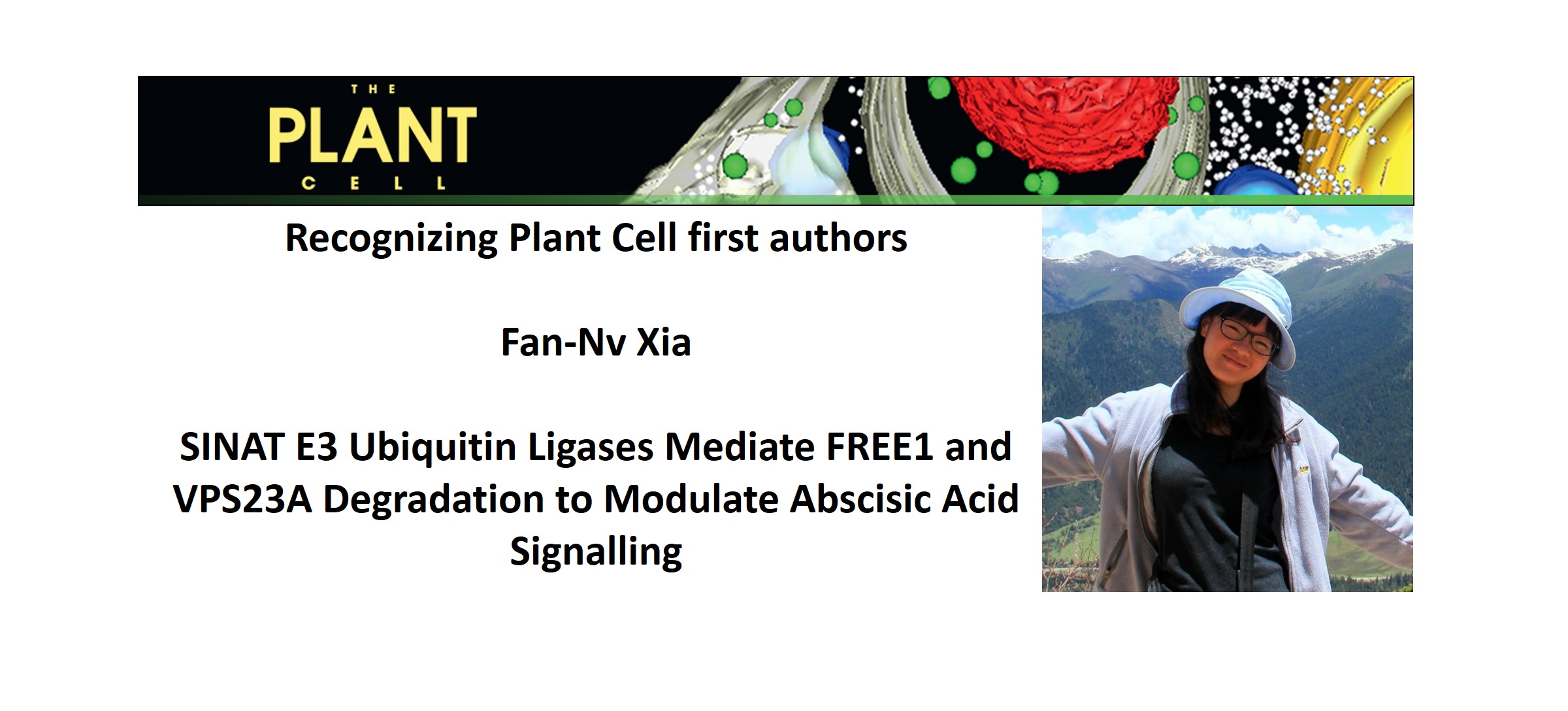Recognizing Plant Cell authors: Fan-Nv Xia
 Fan-Nv Xia, first author of SINAT E3 Ubiquitin Ligases Mediate FREE1 and VPS23A Degradation to Modulate Abscisic Acid Signalling
Fan-Nv Xia, first author of SINAT E3 Ubiquitin Ligases Mediate FREE1 and VPS23A Degradation to Modulate Abscisic Acid Signalling
Current Position: Postdoctoral researcher, School of Life Sciences, SUN YAT-SEN University, China
Education: PhD, 2014-2019, School of Life Sciences, SUN YAT-SEN University, China
Non-scientific Interests: reading, travelling
Brief bio: Six years ago, I knocked on the door of biological research, and chose botany as my major, a less popular and less important subject reckoned by some people. As far as I am concerned, plants are the power behind the thriving of lives on our planet. Although low-key, plants have profound effects on our life and deserve more attention. Following the same complex, I chose protein degradation as my PhD project. ‘Synthesis! Synthesis! Synthesis is what really matters!’ Somebody would say like that and I couldn’t agree more. But the voice of the Nobel Prize winner Ciechanover always lingers in my ears, ‘Our proteins have to die so we shall live!’ Construction is important, but scavenging is indispensable. Imagine living in a city with cleaning system crippled. It would be a definite disaster and lead to ruin soon! It is the same case in a cell.
There are three degradation pathways in plant cells, including ubiquitin-proteasome system (UPS), autophagy-vacuole system, and multi-vesicle body (MVB)-mediated vacuole sorting. The molecular mechanism of each degradation machine is well-understood, while the crosstalk between them remains largely unknown. Our work raised two questions: 1) as huge protein complexes, how do these degradation machines achieve quality control of themselves, especially when damages happen on their elements? 2) how do these three systems coordinate during regulating a specific signaling pathway? Our work demonstrated an E3 ligase family SINAT proteins targeted FREE1 and VPS23A, which are indispensable for MVB biogenesis, for ubiquitination and degradation in both proteasome and vacuole. Notably, we found that SINAT proteins formed homo- or hetero- oligomer in vivo, and the monomers and oligomers tended to choose proteasome or vacuole pathways for degradation respectively. During recovery period of abscisic acid (ABA) treatment, the oligomeric SINAT proteins underwent co-degradation with their target FREE1 through autophagy pathway, leading to reset of cellular homeostasis by interconnecting three degradation systems.
The farther I walk into the forest of unknown, the deeper I’m impressed by the power of technique development in boosting sciences, and the advantage of bioinformatics in mining the treasure of bio-resources. In the following postdoctoral training, I am going to strengthen myself on the two aspects.
姓名:夏凡女
当前职位:中山大学生命科学学院博士后
教育经历:2014-2019 中山大学生命科学学院 博士
2010-2014 中山大学生命科学学院 学士
兴趣爱好:阅读,旅行
个人简介:6年前,我踏入生命科学研究领域,选择了植物学,一个相对冷门、被许多人认为不太重要的学科,开启我的学术生涯。在我看来,作为地球生命繁盛的背景音乐,植物的力量无处不在,却因其润物无声而常被忽视。然而她确实值得并且需要我们的关注。几乎出于同样的情结,我选择了蛋白降解作为博士课题的研究方向。“合成!合成!从无到有才是关键!”也许有人会这么说。我举双手赞成。然而诺奖得主Ciechanover老先生的一句话一直萦绕在我耳边:“Our proteins have to die so we shall live!(我们需以蛋白的死亡换取个体的生存)!”建设无比重要,但清理同样不可忽视。
已知植物细胞中有三套降解回收系统:泛素-蛋白酶体系统(Ubiquitin-Proteasome System, UPS)、自噬(Autophagy)-液泡途径,以及多泡小体(multi-vesicle body, MVB)介导的液泡分选。三种途径各自的工作原理已经基本研究清楚,然而其间的交互对话则知之甚少。我们的工作关注两个问题:1.作为巨大的蛋白复合物,这三种降解机器是如何实现自身的质量控制的?这也是一个“理发匠怎么给自己剃头”的问题。2.不同的蛋白降解途径如何协同调控信号通路?我们的工作展示了E3泛素连接酶SINATs能够靶向MVB途径的核心蛋白FREE1和VPS23A,促进其泛素化,并同时通过蛋白酶体和液泡途径降解。值得注意的是,SINATs蛋白能够在体内形成同源或异源寡聚体,其单体和寡聚体分别倾向于通过蛋白酶体和液泡途径降解。在ABA处理恢复阶段,SINATs蛋白的寡聚体与其底物FREE1通过自噬-液泡途径发生共降解,从而联动三大降解系统重设细胞内的稳态平衡。
在这些年的学术探索中,我深深感受到了技术的突破和创新对于生命科学领域发展的强大推动力,以及生物信息学在探索未知生物资源方面的强大力量。在接下来的博后训练中,我将在这两方面加以拓展。



